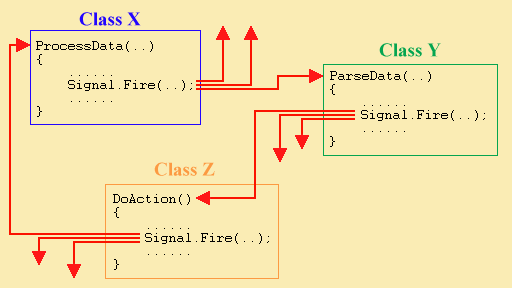Signal Slot Qt Connect
The Qt signals/slots and property system are based on the ability to introspect the objects at runtime. Introspection means being able to list the methods and properties of an object and have all kinds of information about them such as the type of their arguments. QtScript and QML would have hardly been possible without that ability. Signal And Slot Connecting two signals Due to the weak couplings of the Qt signals and slot mechanisms, it is viable to bind signals to each other. It may sound confusing, so let me draw a diagram to make it clear: When an event triggers a specific signal, this emitted signal could be another event, which will emit another specific signal.
- Qt Signal Slot Connection
- Qt Remove Signal Slot Connection
- Qt Signal Slot Connect Disconnect
- Qt Signal Slot Connection Type
 to simplify using this feature.
to simplify using this feature.Back in the old days, signals and slots connections were set up for compile time (or even run time) manually, where developers used the following sentence:
 this is, we stated the sender object's name, the signal we want to connect, the receiver object's name and the slot to connect the signal to.
this is, we stated the sender object's name, the signal we want to connect, the receiver object's name and the slot to connect the signal to.Now there's an automatic way to connect signals and slots by means of QMetaObject's ability to make connections between signals and suitably-named slots. And that's the key: if we use an appropriate naming convention, signals and slots will be properly connected without the need to write additional code for that to happen. So by declaring and implementing a slot with a name that follows the following convention:
uic (the User Interface Compiler of Qt) will automatically generate code in the dialog's setupUi() function to connect button's signal with dialog's slot.
So back to our example, the class implementing the slot must define it like this:

We then write the method's implementatio to carry on an action when the signal is emitted:
In brief, we have seen that by using automatic connection of signals and slots we can count on both a standard naming convention and at the same time an explicit interface for designers to embrace. If the proper source code implements such a given interface, interface designers can later check that everything is working fine without the need to code.
Introduction
Remember old X-Windows call-back system? Generally it isn't type safe and flexible. There are many problems with them. Qt offers a new event handling system: signal-slot connections. Imagine an alarm clock. When alarm is ringing, a signal is being sent (emit). And you're handling it in a slot.
- Every QObject class may have as many signals and slots as you want
- You can emit signals only from within that class, where the signal is located
- You can connect signal with another signal (make chains of signals);
- Every signal and slot can have unlimited count of connections with other.
- ATTENTION! You can't set default value in slot attributes e.g. void mySlot(int i = 0);
Connection
You can connect signal with this template:
QObject::connect (
);
Qt Signal Slot Connection
You have to wrap const char * signal and const char * method into SIGNAL() and SLOT() macros.
And you also can disconnect signal-slot:
QObject::disconnect (
);

Deeper
Widgets emit signals when events occur. For example, a button will emit a clicked signal when it is clicked. A developer can choose to connect to a signal by creating a function (a slot) and calling the connect() function to relate the signal to the slot. Qt's signals and slots mechanism does not require classes to have knowledge of each other, which makes it much easier to develop highly reusable classes. Since signals and slots are type-safe, type errors are reported as warnings and do not cause crashes to occur.
For example, if a Quit button's clicked() signal is connected to the application's quit() slot, a user's click on Quit makes the application terminate. In code, this is written as
Qt Remove Signal Slot Connection
connect(button, SIGNAL (clicked()), qApp, SLOT (quit()));
Connections can be added or removed at any time during the execution of a Qt application, they can be set up so that they are executed when a signal is emitted or queued for later execution, and they can be made between objects in different threads.
The signals and slots mechanism is implemented in standard C++. The implementation uses the C++ preprocessor and moc, the Meta Object Compiler, included with Qt. Code generation is performed automatically by Qt's build system. Developers never have to edit or even look at the generated code.
In addition to handling signals and slots, the Meta Object Compiler supports Qt's translation mechanism, its property system, and its extended runtime type information. It also makes runtime introspection of C++ programs possible in a way that works on all supported platforms.
Qt Signal Slot Connect Disconnect
To make moc compile the meta object classes don't forget to add the Q_OBJECT macro to your class.